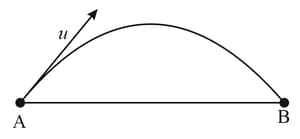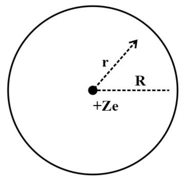Applications of Gauss's Law
Applications of Gauss's Law: Overview
This topic covers concepts, such as Electric Field due to a Long Line Charge Using Gauss's Law, Electric Field due to a Large Charged Sheet Using Gauss's Law, and Electric Field due to a Charged Spherical Shell Using Gauss's Law.
Important Questions on Applications of Gauss's Law
Applying Gauss theorem, the expression for the electric field intensity at a point due to an infinitely long, thin, uniformly charged straight wire is
A hollow charged metal sphere has radius . If the potential difference between its surface and a point at a distance from the centre is, then electric field intensity at a distance is:
In the figure shown, there is a large sheet of charge of uniform surface charge density . A charge particle of charge and mass is projected from a point on the sheet with a speed with angle of projection such that it lands at maximum distance from on the sheet. Neglecting gravity, find the time of flight.

A conducting spherical shell of radius has a charge units. The electric field due to the shell at a point
A conducting spherical shell of radius has a charge units. The electric field due to the shell at a point
An electron is moving around an infinite linear charge in a circular path of diameter . If linear charge density is and the speed of the electron is written as, then find accurate up to two digits after the decimal point. (, )
solid conducting sphere of radius is enclosed by a thin metallic shell of radius charge of is given to the inner sphere. If the metallic shell is earthed, then the heat generated in the process is
The electric potential at the surface of a charged spherical conductor of radius is . Electric potential at its centre in volt is
An electron of energy is fired from a distance of perpendicularly towards an infinite charged conducting plate. What should be the minimum charge density on plate so that electron fails to strike the plate?
A particle of mass is placed at some height above a uniformly charged horizontal infinite non conducting plate having a surface charge density . What should be the charge on the particle so that on releasing it will not fall down. Take,
Two metallic plates each of area is placed parallel to each other at a separation of . Both have charges of equal magnitude but of opposite nature. If the magnitude of electric field in space between them is , then calculate the magnitude of charge on each plate.
A charge of is given to a metallic plate of area . Determine the intensity of electric fields at points near by.
An infinite line charge produces an electric field of at from it. Determine the linear charge density.
The intensity of electric field due to a charged sphere at a point at a distance of from in centre is . The radius of sphere is . Determine the intensity of electric field at a distance of from the centre.
Consider two infinite parallel planes having charge densities and respectively. What is the magnitude of the electric field at some point in the region between them?
Consider two long straight line charges having linear charge densities and . Derive expression for the force per unit length acting between them.
Graph the variation of electric field with distance for a uniformly charged non-conducting sheet.
Write the expression for force per unit area on a charged spherical conductor and give its direction.
Electric field intensity due to a long straight charged wire varies with as shown in
An early model of an atom considered it to have a positively charged point nucleus of charge surrounded by a uniform density of negative charge upto a radius . The atom as a whole is neutral. The electric field at a distance from the nucleus is

